Semantic Information Recovery in Wireless Networks
Abstract
1. Introduction
2. Related Work
- A.
- How accurately can the symbols of communication be transmitted? (The technical problem.)
- B.
- How precisely do the transmitted symbols convey the desired meaning? (The semantic problem.)
- C.
- How effectively does the received meaning affect conduct in the desired way? (The effectiveness problem.)
3. Main Contributions
- Motivated by the approach of Bao, Basu et al. [16,17], we adopt the terminus of a semantic source. Inspired by Weaver’s notion, we bring it to the context of communications by considering the complete Markov chain, including semantic source, communications source, transmit signal, communication channel, and received signal in contrast to both [16,17]. Further, we also extend beyond the example of deterministic entailment relations between “models” and “messages” based on propositional logic in [16,17] to probabilistic semantic channels.
- We define the task of semantic communication in the sense that we perform data compression, coding, and transmission of messages observed such that the semantic Random Variable (RV) at a recipient is best preserved. Basically, we implement joint source-channel coding of messages conveying the semantic RV, but not differentiating between Levels A and B. We formulate the semantic communication design either as an Information Maximization or as an Information Bottleneck (IB) optimization problem [29,30,31].
- –
- Although the approach pursued here again leads to an IB problem as in [26], our article introduces a new classification and perspective of semantic communication and different ML-based solution approaches. Different from [26], we solve the IB problem maximizing the mutual information for a fixed encoder output dimension that bounds the information rate.
- –
- Finally, we propose the ML-based semantic communication system SINFONY for a distributed multipoint scenario in contrast to [26]: SINFONY communicates the meaning behind multiple messages that are observed at different senders to a single receiver for semantic recovery. Compared to the distributed scenario in [33,34], we include the communication channel.
- We analyze SINFONY by processing images as an example of messages. Notably, numerical results reveal a tremendous rate-normalized SNR shift up to 20 dB compared to classically designed communication systems.
4. A Framework for Semantics
4.1. Philosophical Considerations
4.2. Semantic System Model
4.2.1. Semantic Source and Channel
4.2.2. Semantic Channel Encoding
4.3. Semantic Communication Design via InfoMax Principle
4.4. Classical Design Approach
4.5. Information Bottleneck View
4.5.1. Semantic Information Bottleneck
4.5.2. Variational Information Bottleneck
4.6. Implementation Considerations
Reparametrization Trick
5. Example of Semantic Information Recovery
5.1. ResNet
5.2. Distributed Semantic Communication Design Approach
5.3. Optimization Details
5.4. Numerical Results and Discussion
- Central: Central and joint processing of full image information by the ResNet classifier, see Figure 2. It indicates the maximum achievable accuracy.
- SINFONY - Perfect com.: The proposed distributed design SINFONY trained with perfect communication links and without channel encoding, i.e., Tx and Rx module, but with Tx normalization layer. Thus, the plain and power-constrained features are transmitted with channel uses. It serves as the benchmark since it indicates the maximum performance of the distributed design.
- SINFONY - AWGN: SINFONY Perfect com. evaluated with AWGN channel.
- SINFONY - AWGN + training: SINFONY Perfect com. trained with AWGN channel.
- SINFONY - Tx/Rx (): SINFONY trained with channel encoding, i.e., Tx and Rx module, and channel uses.
- SINFONY - Tx/Rx (): SINFONY trained with channel encoding and channel uses for feature compression.
- SINFONY - Classic digital com.: SINFONY - Perfect com. with classic digital communications (Huffman coding, LDPC coding with belief propagation decoding, and digital modulation) as additional Tx and Rx modules. For details, see Section 5.4.4.
- SINFONY - Analog semantic AE: SINFONY - Perfect com. with ML-based analog communications (AE with regard to ) as additional Tx and Rx modules. It is basically the semantic communication approach from [19,21,28,32]. For details, see Section 5.4.5.
5.4.1. MNIST Dataset
5.4.2. CIFAR10 Dataset
5.4.3. Channel Uses Constraint
5.4.4. Semantic vs. Classic Design
5.4.5. SINFONY vs. Analog “Semantic” Autoencoder
6. Conclusions
Outlook
- Numerical Comparison to Variational IB: It remains unclear if solving the variational IB problem (21) holds benefits compared to our proposed approach.
- Implementation: Optimization with the reparametrization trick requires a known differential channel model and training at one location with dedicated hardware such as graphics processing units [53]. In addition, large amounts of labeled data are required with data-driven ML techniques, which can be expensive and time-consuming to acquire and process. Hence, further research is required to clarify how a semantic design can be implemented efficiently in practice.
- Semantic Modeling: Developing effective models of semantics is crucial, and thus we proposed the usage of probabilistic models. If the underlying problem can be described by a well-known model, e.g., a physical process to be measured and processed by a sensor network [32], a promising idea is to apply model-based approaches based on Bayesian inference for encoding and decoding—potentially combined with the technique of deep unfolding. In the context of NLP, design of knowledge graphs such as ontologies or taxonomies is a promising modeling approach for human language.
- Inconsistent Knowledge Bases: We assumed that sender and recipient share the same background knowledge base: How does performance deteriorate if there is a mismatch and how to deal with this problem [27]?
Author Contributions
Funding
Institutional Review Board Statement
Informed Consent Statement
Data Availability Statement
Conflicts of Interest
Abbreviations
| ADF | Automatic Differentiation Framework |
| AE | Autoencoder |
| AI | Artificial Intelligence |
| AWGN | Additive White Gaussian Noise |
| CNN | Convolutional Neural Network |
| dim. | Dimension |
| DNN | Deep Neural Network |
| ELBO | Evidence Lower BOund |
| IB | Information Bottleneck |
| InfoMax | Information Maximization |
| JSCC | Joint Source-Channel Coding |
| KL | Kullback–Leibler |
| MILBO | Mutual Information Lower BOund |
| MI | Mutual Information |
| ML | Machine Learning |
| NLP | Natural Language Processing |
| Probability Density Function | |
| pmf | Probability Mass Function |
| ReLU | Rectified Linear Unit |
| ResNet | Residual Network |
| res. un. | Residual Unit |
| RV | Random Variable |
| Rx | Receiver |
| SGD | Stochastic Gradient Descent |
| SINFONY | Semantic INFOrmation traNsmission and recoverY |
| Tx | Transmitter |
| VAE | Variational Autoencoder |
References
- Shannon, C.E. A Mathematical Theory of Communication. Bell Syst. Tech. J. 1948, 27, 379–423. [Google Scholar] [CrossRef]
- Weaver, W. Recent Contributions to the Mathematical Theory of Communication. In The Mathematical Theory of Communication; The University of Illinois Press: Uraban, IL, USA, 1949; Volume 10, pp. 261–281. [Google Scholar]
- Xu, W.; Yang, Z.; Ng, D.W.K.; Levorato, M.; Eldar, Y.C.; Debbah, M. Edge Learning for B5G Networks with Distributed Signal Processing: Semantic Communication, Edge Computing, and Wireless Sensing. IEEE J. Sel. Top. Signal Process. 2023, 17, 9–39. [Google Scholar] [CrossRef]
- Gastpar, M.; Rimoldi, B.; Vetterli, M. To code, or not to code: Lossy source-channel communication revisited. IEEE Trans. Inf. Theory 2003, 49, 1147–1158. [Google Scholar] [CrossRef]
- Gastpar, M.; Vetterli, M. Source-Channel Communication in Sensor Networks. In Information Processing in Sensor Networks; Goos, G., Hartmanis, J., van Leeuwen, J., Zhao, F., Guibas, L., Eds.; Springer: Berlin/Heidelberg, Germany, 2003; Volume 2634, pp. 162–177. [Google Scholar] [CrossRef]
- O’Shea, T.; Hoydis, J. An Introduction to Deep Learning for the Physical Layer. IEEE Trans. Cogn. Commun. Netw. 2017, 3, 563–575. [Google Scholar] [CrossRef]
- Simeone, O. A Very Brief Introduction to Machine Learning with Applications to Communication Systems. IEEE Trans. Cogn. Commun. Netw. 2018, 4, 648–664. [Google Scholar] [CrossRef]
- Beck, E.; Bockelmann, C.; Dekorsy, A. CMDNet: Learning a Probabilistic Relaxation of Discrete Variables for Soft Detection with Low Complexity. IEEE Trans. Commun. 2021, 69, 8214–8227. [Google Scholar] [CrossRef]
- Popovski, P.; Simeone, O.; Boccardi, F.; Gündüz, D.; Sahin, O. Semantic-Effectiveness Filtering and Control for Post-5G Wireless Connectivity. J. Indian Inst. Sci. 2020, 100, 435–443. [Google Scholar] [CrossRef]
- Strinati, E.C.; Barbarossa, S. 6G networks: Beyond Shannon towards semantic and goal-oriented communications. Comput. Netw. 2021, 190, 107930. [Google Scholar] [CrossRef]
- Lan, Q.; Wen, D.; Zhang, Z.; Zeng, Q.; Chen, X.; Popovski, P.; Huang, K. What is Semantic Communication? A View on Conveying Meaning in the Era of Machine Intelligence. J. Commun. Inf. Netw. 2021, 6, 336–371. [Google Scholar] [CrossRef]
- Uysal, E.; Kaya, O.; Ephremides, A.; Gross, J.; Codreanu, M.; Popovski, P.; Assaad, M.; Liva, G.; Munari, A.; Soret, B.; et al. Semantic Communications in Networked Systems: A Data Significance Perspective. IEEE/ACM Trans. Netw. 2022, 36, 233–240. [Google Scholar] [CrossRef]
- Gündüz, D.; Qin, Z.; Aguerri, I.E.; Dhillon, H.S.; Yang, Z.; Yener, A.; Wong, K.K.; Chae, C.B. Beyond Transmitting Bits: Context, Semantics, and Task-Oriented Communications. IEEE J. Sel. Areas Commun. 2023, 41, 5–41. [Google Scholar] [CrossRef]
- Floridi, L. Philosophical Conceptions of Information. In Formal Theories of Information: From Shannon to Semantic Information Theory and General Concepts of Information; Lecture Notes in Computer Science; Springer: Berlin/Heidelberg, Germany, 2009; pp. 13–53. [Google Scholar] [CrossRef]
- Hofkirchner, W. Emergent Information: A Unified Theory of Information Framework; World Scientific: Singapore, 2013; Volume 3. [Google Scholar]
- Bao, J.; Basu, P.; Dean, M.; Partridge, C.; Swami, A.; Leland, W.; Hendler, J.A. Towards a theory of semantic communication. In Proceedings of the 2011 IEEE Network Science Workshop (NSW), West Point, NY, USA, 22–24 June 2011; pp. 110–117. [Google Scholar] [CrossRef]
- Basu, P.; Bao, J.; Dean, M.; Hendler, J. Preserving quality of information by using semantic relationships. Pervasive Mob. Comput. 2014, 11, 188–202. [Google Scholar] [CrossRef]
- Güler, B.; Yener, A.; Swami, A. The Semantic Communication Game. IEEE Trans. Cogn. Commun. Netw. 2018, 4, 787–802. [Google Scholar] [CrossRef]
- Farsad, N.; Rao, M.; Goldsmith, A. Deep Learning for Joint Source-Channel Coding of Text. In Proceedings of the 2018 IEEE International Conference on Acoustics, Speech and Signal Processing (ICASSP), Calgary, AB, Canada, 15–20 April 2018; pp. 2326–2330. [Google Scholar] [CrossRef]
- Xie, H.; Qin, Z.; Li, G.Y.; Juang, B.H. Deep Learning based Semantic Communications: An Initial Investigation. In Proceedings of the 2020 IEEE Global Communications Conference (GLOBECOM), Tapei, Taiwan, 7–11 December 2020; pp. 1–6. [Google Scholar] [CrossRef]
- Xie, H.; Qin, Z.; Li, G.Y.; Juang, B.H. Deep Learning Enabled Semantic Communication Systems. IEEE Trans. Signal Process. 2021, 69, 2663–2675. [Google Scholar] [CrossRef]
- Weng, Z.; Qin, Z.; Li, G.Y. Semantic Communications for Speech Signals. In Proceedings of the 2021 IEEE International Conference on Communications (ICC), Virtual Conference, 14–23 June 2021; pp. 1–6. [Google Scholar] [CrossRef]
- Weng, Z.; Qin, Z.; Tao, X.; Pan, C.; Liu, G.; Li, G.Y. Deep Learning Enabled Semantic Communications with Speech Recognition and Synthesis. IEEE Trans. Wirel. Commun. 2023, 1. [Google Scholar] [CrossRef]
- Xie, H.; Qin, Z.; Tao, X.; Letaief, K.B. Task-Oriented Multi-User Semantic Communications. IEEE J. Sel. Areas Commun. 2022, 40, 2584–2597. [Google Scholar] [CrossRef]
- Wang, B.; Li, R.; Zhu, J.; Zhao, Z.; Zhang, H. Knowledge Enhanced Semantic Communication Receiver. IEEE Commun. Lett. 2023, 1. [Google Scholar] [CrossRef]
- Shao, J.; Mao, Y.; Zhang, J. Learning Task-Oriented Communication for Edge Inference: An Information Bottleneck Approach. IEEE J. Sel. Areas Commun. 2022, 40, 197–211. [Google Scholar] [CrossRef]
- Luo, X.; Chen, H.H.; Guo, Q. Semantic Communications: Overview, Open Issues, and Future Research Directions. IEEE Trans. Wirel. Commun. 2022, 29, 210–219. [Google Scholar] [CrossRef]
- Bourtsoulatze, E.; Kurka, D.B.; Gündüz, D. Deep Joint Source-Channel Coding for Wireless Image Transmission. IEEE Trans. Cogn. Commun. Netw. 2019, 5, 567–579. [Google Scholar] [CrossRef]
- Tishby, N.; Pereira, F.C.; Bialek, W. The information bottleneck method. In Proceedings of the 37th Annual Allerton Conference on Communication, Control and Computing, Monticello, IL, USA, 22–24 September 1999; pp. 368–377. [Google Scholar] [CrossRef]
- Hassanpour, S.; Monsees, T.; Wübben, D.; Dekorsy, A. Forward-Aware Information Bottleneck-Based Vector Quantization for Noisy Channels. IEEE Trans. Commun. 2020, 68, 7911–7926. [Google Scholar] [CrossRef]
- Hassanpour, S.; Wübben, D.; Dekorsy, A. Forward-Aware Information Bottleneck-Based Vector Quantization: Multiterminal Extensions for Parallel and Successive Retrieval. IEEE Trans. Commun. 2021, 69, 6633–6646. [Google Scholar] [CrossRef]
- Beck, E.; Shin, B.S.; Wang, S.; Wiedemann, T.; Shutin, D.; Dekorsy, A. Swarm Exploration and Communications: A First Step towards Mutually-Aware Integration by Probabilistic Learning. Electronics 2023, 12, 1908. [Google Scholar] [CrossRef]
- Aguerri, I.E.; Zaidi, A. Distributed Variational Representation Learning. IEEE Trans. Pattern Anal. Mach. Intell. 2021, 43, 120–138. [Google Scholar] [CrossRef] [PubMed]
- Shao, J.; Mao, Y.; Zhang, J. Task-Oriented Communication for Multidevice Cooperative Edge Inference. IEEE Trans. Wirel. Commun. 2023, 22, 73–87. [Google Scholar] [CrossRef]
- Simeone, O. A Brief Introduction to Machine Learning for Engineers. Found. Trends® Signal Process. 2018, 12, 200–431. [Google Scholar] [CrossRef]
- Vincent, P.; Larochelle, H.; Lajoie, I.; Bengio, Y.; Manzagol, P.A. Stacked Denoising Autoencoders: Learning Useful Representations in a Deep Network with a Local Denoising Criterion. J. Mach. Learn. Res. 2010, 11, 3371–3408. [Google Scholar]
- Hassanpour, S. Source & Joint Source-Channel Coding Schemes Based on the Information Bottleneck Framework. Ph.D. Thesis, University of Bremen, Bremen, Germany, 2022. [Google Scholar]
- Sana, M.; Strinati, E.C. Learning Semantics: An Opportunity for Effective 6G Communications. In Proceedings of the 2022 IEEE 19th Annual Consumer Communications Networking Conference (CCNC), Las Vegas, NV, USA, 8–11 January 2022; pp. 631–636. [Google Scholar] [CrossRef]
- Farsad, N.; Shlezinger, N.; Goldsmith, A.J.; Eldar, Y.C. Data-Driven Symbol Detection Via Model-Based Machine Learning. In Proceedings of the 2021 IEEE Statistical Signal Processing Workshop (SSP), Rio de Janeiro, Brazil, 11–14 July 2021; pp. 571–575. [Google Scholar] [CrossRef]
- Goldfeld, Z.; Polyanskiy, Y. The Information Bottleneck Problem and its Applications in Machine Learning. IEEE J. Sel. Areas Inf. Theory 2020, 1, 19–38. [Google Scholar] [CrossRef]
- Zaidi, A.; Estella-Aguerri, I.; Shamai (Shitz), S. On the Information Bottleneck Problems: Models, Connections, Applications and Information Theoretic Views. Entropy 2020, 22, 151. [Google Scholar] [CrossRef]
- Kurkoski, B.M.; Yagi, H. Quantization of Binary-Input Discrete Memoryless Channels. IEEE Trans. Inf. Theory 2014, 60, 4544–4552. [Google Scholar] [CrossRef]
- Lewandowsky, J.; Bauch, G. Information-Optimum LDPC Decoders Based on the Information Bottleneck Method. IEEE Access 2018, 6, 4054–4071. [Google Scholar] [CrossRef]
- Alemi, A.A.; Fischer, I.; Dillon, J.V.; Murphy, K. Deep Variational Information Bottleneck. In Proceedings of the 5th International Conference on Learning Representations (ICLR), Toulon, France, 24–26 April 2017; pp. 1–19. [Google Scholar]
- Belghazi, M.I.; Baratin, A.; Rajeswar, S.; Ozair, S.; Bengio, Y.; Courville, A.; Hjelm, R.D. MINE: Mutual Information Neural Estimation. In Proceedings of the 35th International Conference on Machine Learning (PMLR), Stockholm, Sweden, 10–15 June 2018. [Google Scholar]
- Cover, T.M.; Thomas, J.A. Elements of Information Theory, 2nd ed.; Wiley-Interscience: Hoboken, NJ, USA, 2006. [Google Scholar]
- He, K.; Zhang, X.; Ren, S.; Sun, J. Deep Residual Learning for Image Recognition. In Proceedings of the 29th IEEE Conference on Computer Vision and Pattern Recognition (CVPR), Las Vegas, NV, USA, 27–30 June 2016; pp. 770–778. [Google Scholar]
- He, K.; Zhang, X.; Ren, S.; Sun, J. Identity Mappings in Deep Residual Networks. In Proceedings of the European Conference on Computer Vision 2016 (ECCV), Amsterdam, The Netherlands, 11–14 October 2016; Lecture Notes in Computer Science. pp. 630–645. [Google Scholar] [CrossRef]
- Abadi, M.; Agarwal, A.; Barham, P.; Brevdo, E.; Chen, Z.; Citro, C.; Corrado, G.S.; Davis, A.; Dean, J.; Devin, M.; et al. TensorFlow: Large-Scale Machine Learning on Heterogeneous Systems. arXiv 2016, arXiv:1603.04467. [Google Scholar]
- Beck, E. Semantic Information Transmission and Recovery (SINFONY) Software. Zenodo. 2023. Available online: https://doi.org/10.5281/zenodo.8006567 (accessed on 1 July 2023).
- He, K.; Zhang, X.; Ren, S.; Sun, J. Delving Deep into Rectifiers: Surpassing Human-Level Performance on ImageNet Classification. In Proceedings of the IEEE International Conference on Computer Vision (ICCV), Santiago, Chile, 7–13 December 2015; pp. 1026–1034. [Google Scholar]
- Hoydis, J.; Cammerer, S.; Aoudia, F.A.; Vem, A.; Binder, N.; Marcus, G.; Keller, A. Sionna: An Open-Source Library for Next-Generation Physical Layer Research. arXiv 2022, arXiv:2203.11854. [Google Scholar] [CrossRef]
- Beck, E.; Bockelmann, C.; Dekorsy, A. Model-free Reinforcement Learning of Semantic Communication by Stochastic Policy Gradient. arXiv 2023, arXiv:2305.03571. [Google Scholar] [CrossRef]
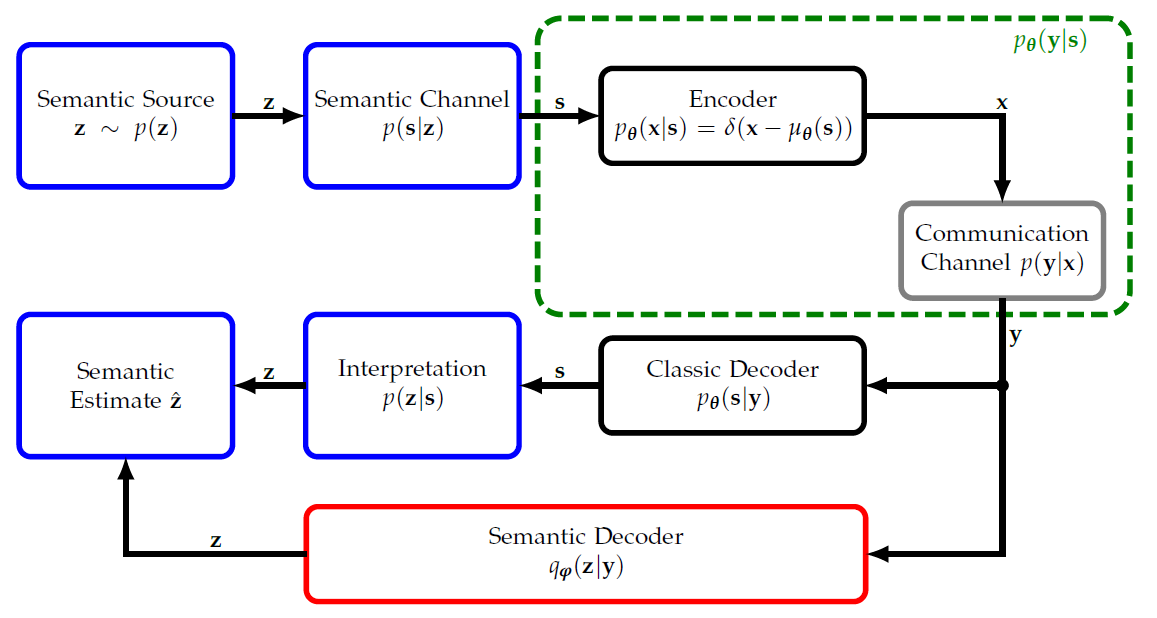
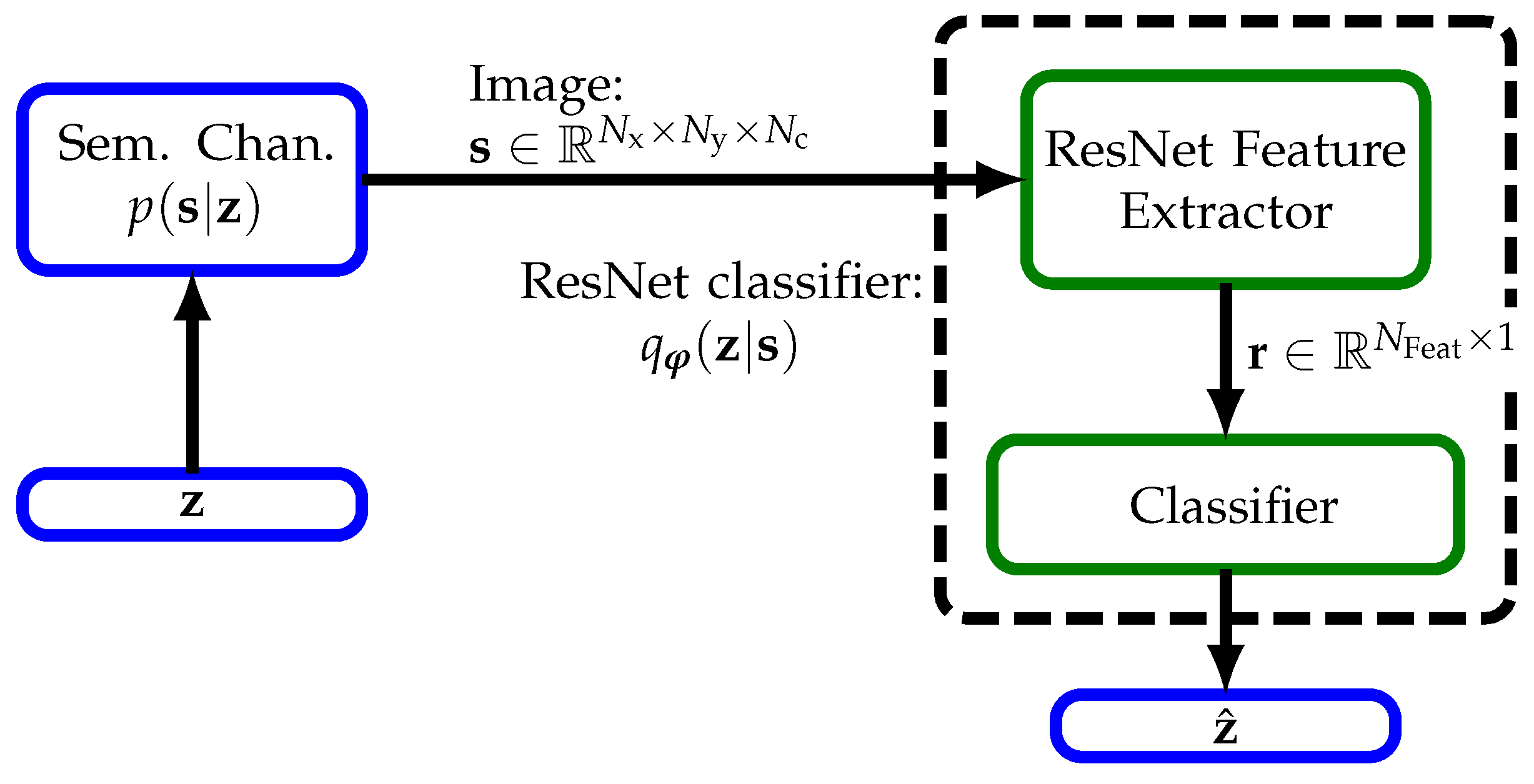

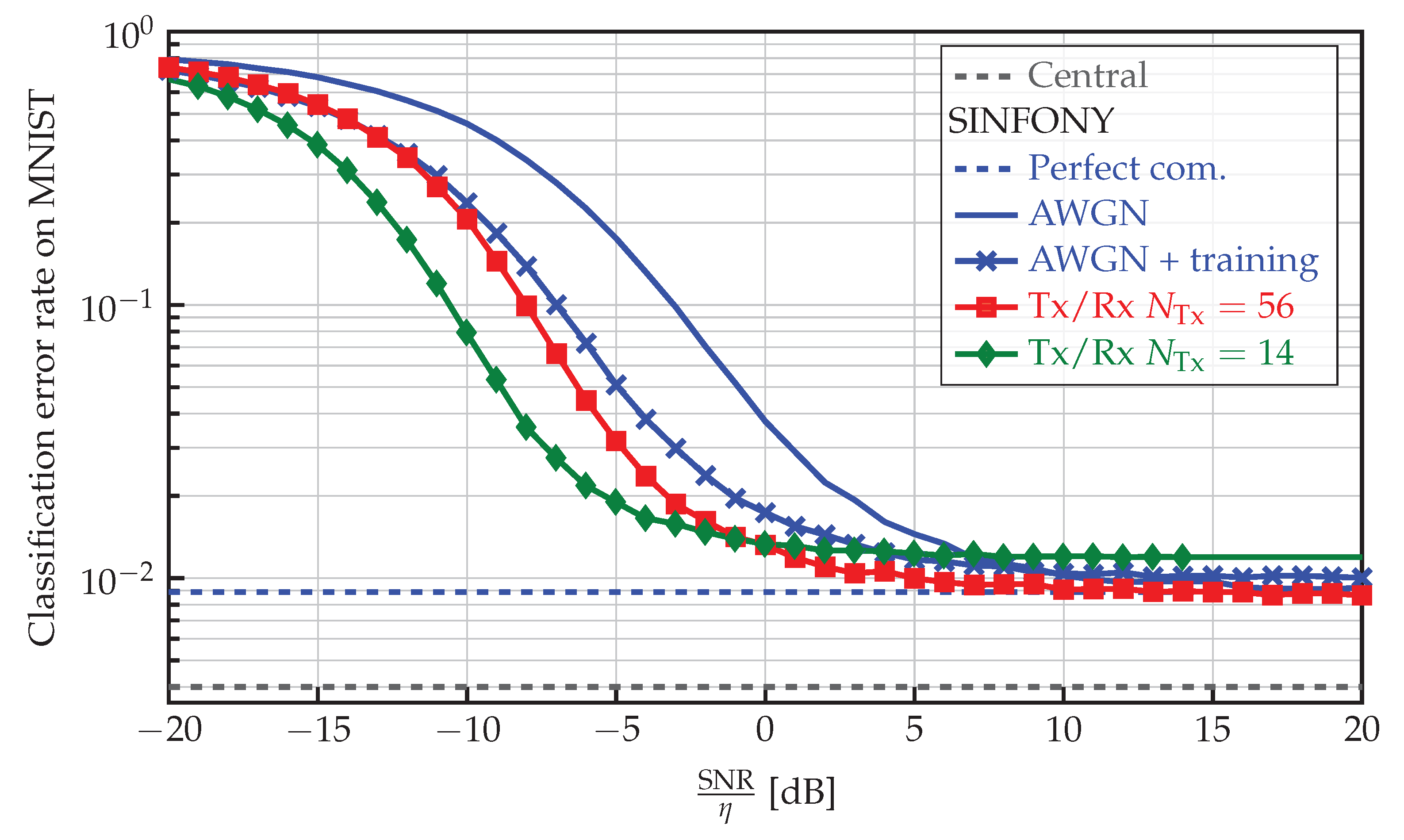
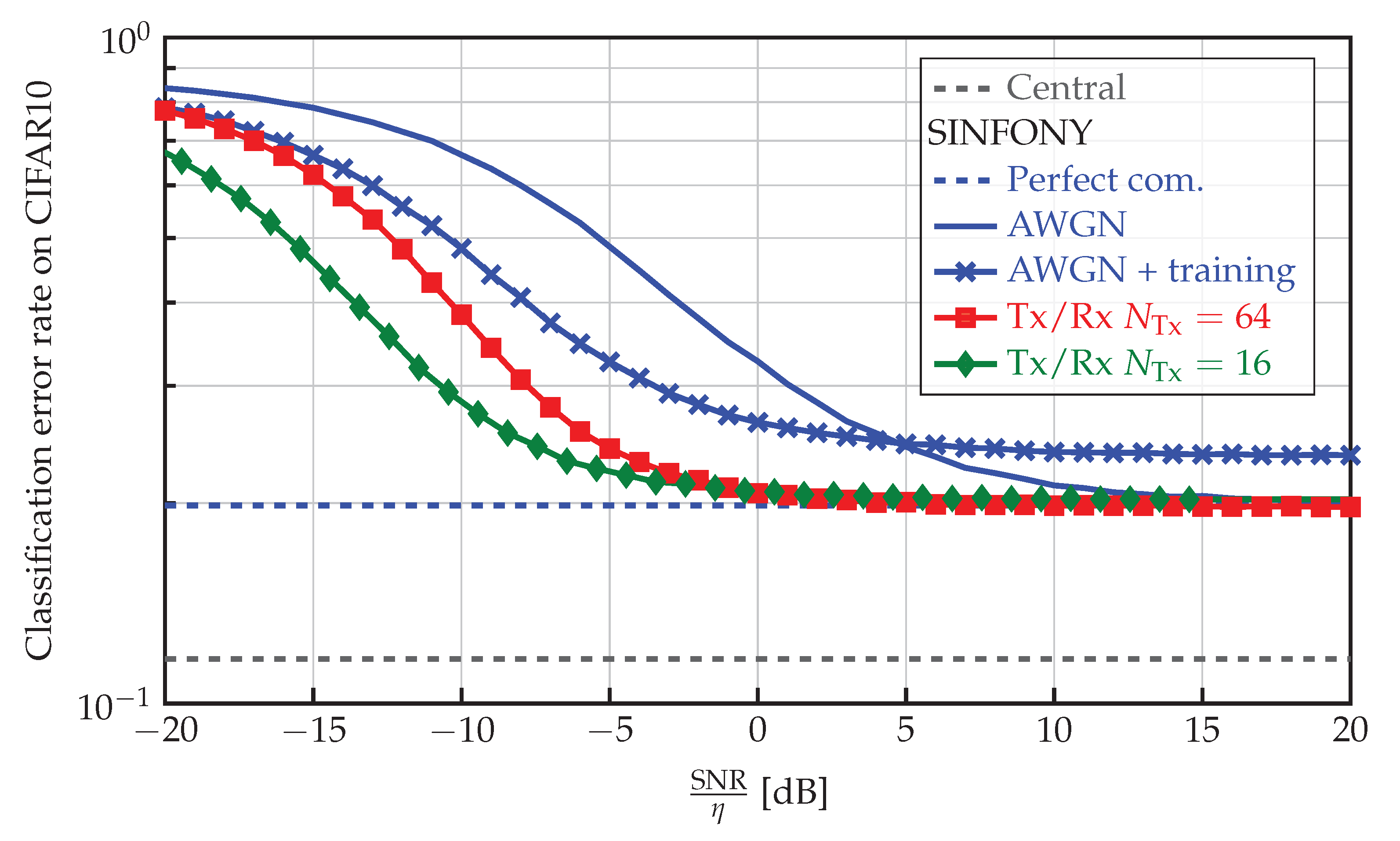
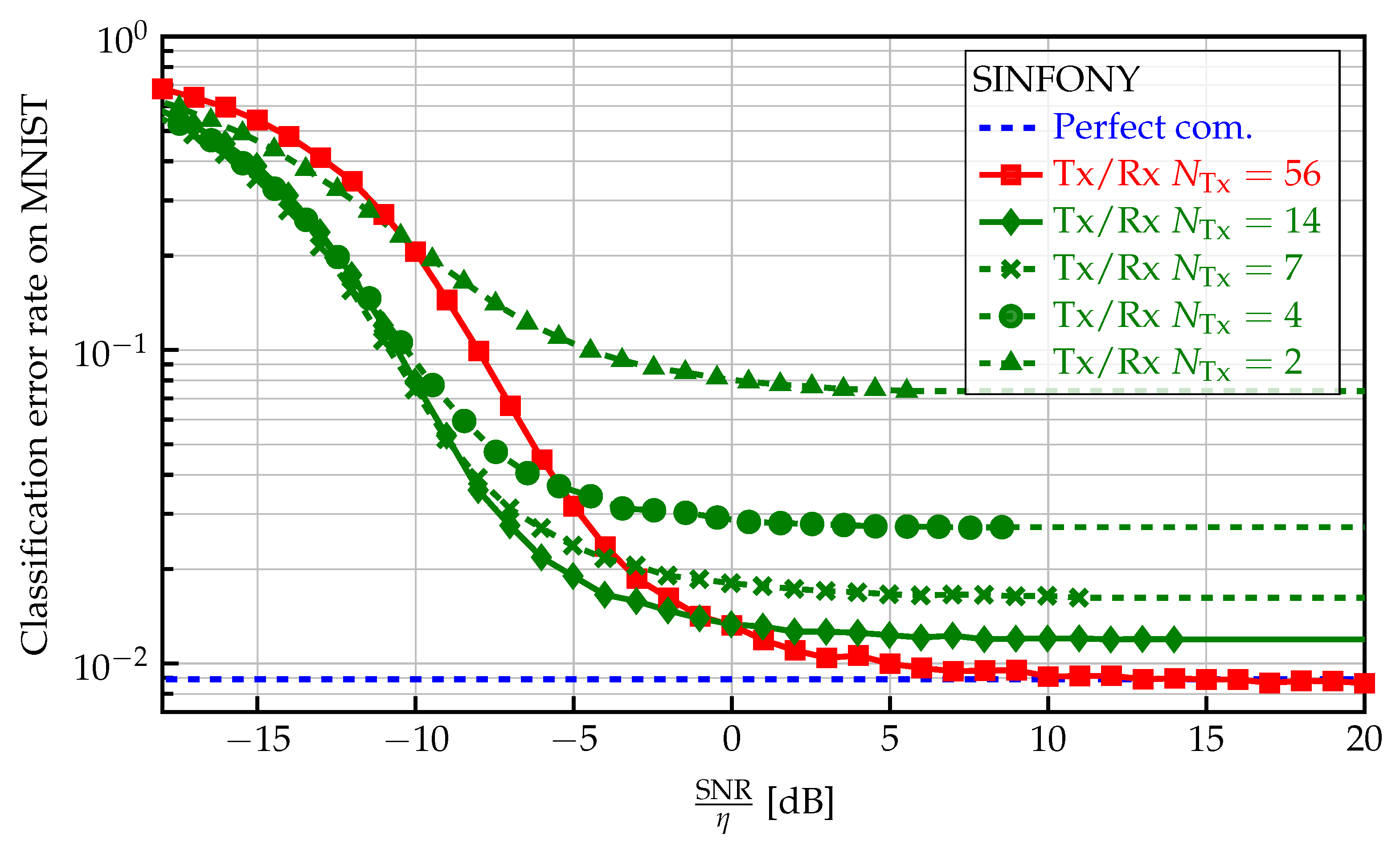
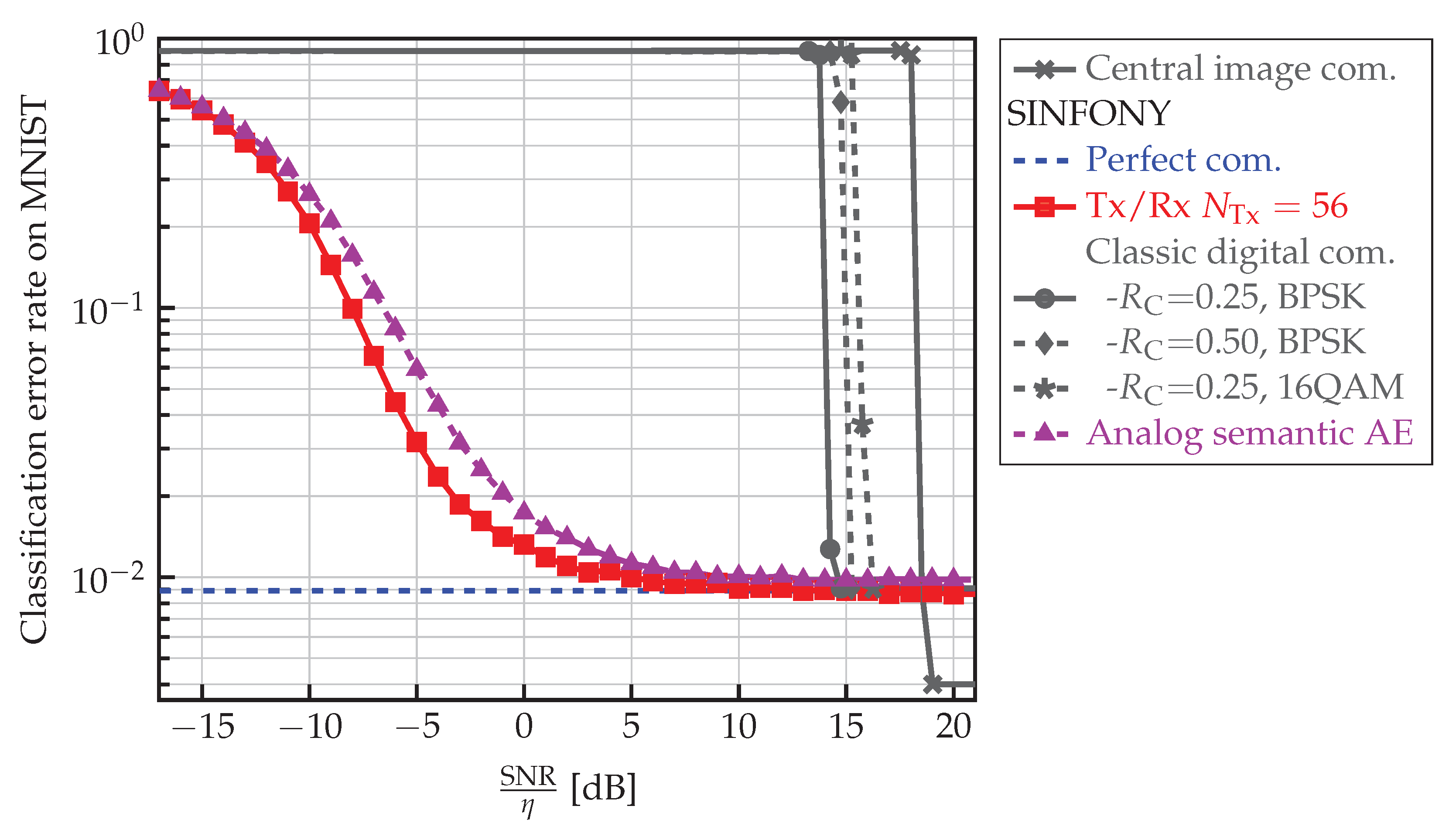
| Component | Layer | Dimension |
|---|---|---|
| Input | Image (MNIST, CIFAR10) | , |
| Conv2D | , | |
| Feature | ResNetBlock (2/3 res. un.) | , |
| Extractor | ResNetBlock (2/3 res. un.) | , |
| ResNetBlock (2/3 res. un.) | , | |
| Batch Normalization | , | |
| ReLU activation | , | |
| GlobalAvgPool2D | , | |
| Tx | ReLU | |
| Linear | ||
| Normalization (dim.) | ||
| Channel | AWGN | |
| Rx | ReLU ( shared) | |
| GlobalAvgPool2D | ||
| Classifier | Softmax |
| Parameter Name | Variable | Value (MNIST, CIFAR10) |
|---|---|---|
| Batch size | 64 | |
| Epoch number | 20, 200 | |
| Learning rate | Schedule: | |
| with , | ||
| Optimizer | SGD with momentum | |
| Preprocessing | Input normalization to | |
| Training SNR range | dB | |
| Training dataset size | 60 k, 50 k | |
| Validation dataset size | 10 k | |
| Weight decay | ||
| Weight initialization | Glorot uniform, ReLU: He uniform | |
| Encoder normalization | dim. | Batch dimension |
| Rx layer width | 56, 64 |
Disclaimer/Publisher’s Note: The statements, opinions and data contained in all publications are solely those of the individual author(s) and contributor(s) and not of MDPI and/or the editor(s). MDPI and/or the editor(s) disclaim responsibility for any injury to people or property resulting from any ideas, methods, instructions or products referred to in the content. |
© 2023 by the authors. Licensee MDPI, Basel, Switzerland. This article is an open access article distributed under the terms and conditions of the Creative Commons Attribution (CC BY) license (https://creativecommons.org/licenses/by/4.0/).
Share and Cite
Beck, E.; Bockelmann, C.; Dekorsy, A. Semantic Information Recovery in Wireless Networks. Sensors 2023, 23, 6347. https://doi.org/10.3390/s23146347
Beck E, Bockelmann C, Dekorsy A. Semantic Information Recovery in Wireless Networks. Sensors. 2023; 23(14):6347. https://doi.org/10.3390/s23146347
Chicago/Turabian StyleBeck, Edgar, Carsten Bockelmann, and Armin Dekorsy. 2023. "Semantic Information Recovery in Wireless Networks" Sensors 23, no. 14: 6347. https://doi.org/10.3390/s23146347
APA StyleBeck, E., Bockelmann, C., & Dekorsy, A. (2023). Semantic Information Recovery in Wireless Networks. Sensors, 23(14), 6347. https://doi.org/10.3390/s23146347






